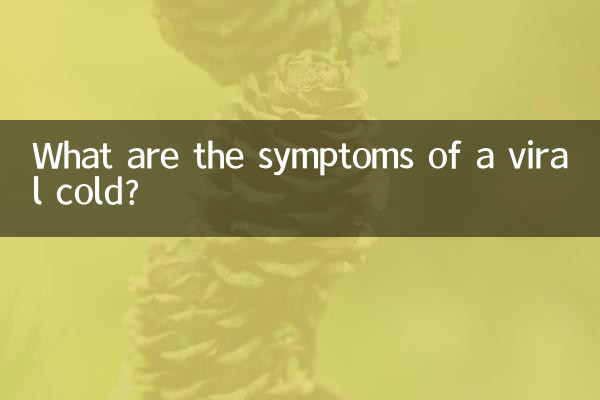What are the symptoms of a viral cold?
Viral colds have become one of the hot topics recently, especially during periods when seasons change and temperatures fluctuate greatly. Understanding the symptoms of viral colds, how they are spread, and preventive measures is crucial to protecting yourself and your family’s health. This article will provide a detailed explanation of the symptoms of viral colds and provide structured data to help readers quickly grasp key information.
1. Common symptoms of viral colds

Viral colds are respiratory infections caused by a variety of viruses. Symptoms vary from person to person, but usually include the following:
| Symptom type | Specific performance | duration |
|---|---|---|
| respiratory symptoms | Congestion, runny nose, sneezing, sore throat | 3-7 days |
| systemic symptoms | Fever (usually low grade), fatigue, headache | 1-3 days |
| Other symptoms | Cough, muscle aches, loss of appetite | 5-10 days |
2. The difference between viral colds, common colds and influenza
Many people easily confuse viral colds with the common cold or flu. Here are the main differences between the three:
| Type | Pathogen | Symptom severity | Risk of complications |
|---|---|---|---|
| Virus cold | Various viruses (e.g. rhinovirus, coronavirus) | mild to moderate | lower |
| common cold | Mainly rhinovirus | Mild | low |
| influenza | Influenza virus (type A, type B) | moderate to severe | higher (e.g. pneumonia) |
3. Transmission routes of viral colds
Viral colds are mainly spread through the following ways:
| Communication method | Specific instructions |
|---|---|
| droplet spread | Droplets produced when the patient coughs or sneezes are inhaled by others |
| contact spread | Touching your mouth and nose after coming into contact with virus-contaminated objects (such as doorknobs, mobile phones) |
| airborne | Spending long periods of time with patients in a confined space |
4. How to prevent viral colds
The key to preventing viral colds is to block transmission routes and enhance your own immunity. The following are specific preventive measures:
| Precautions | Specific methods |
|---|---|
| personal hygiene | Wash your hands frequently, using soap or hand sanitizer, for at least 20 seconds |
| Wear a mask | Wear a medical mask in crowded or confined spaces |
| Enhance immunity | Balanced diet, adequate sleep, moderate exercise |
| avoid contact | Reduce close contact with people with colds |
5. Treatment suggestions for viral colds
Most viral colds are self-limiting illnesses that resolve on their own without the need for special treatment. Here are some ways to relieve symptoms:
| Symptoms | Mitigation methods |
|---|---|
| Nasal congestion, runny nose | Use a saline nasal spray or nasal rinse |
| Fever, headache | Take fever-reducing medicine (such as acetaminophen) |
| sore throat | Drink plenty of warm water and take throat lozenges |
6. When do you need medical treatment?
Although viral colds usually do not require medical attention, the following situations require prompt medical attention:
| Symptoms | Possible serious problems |
|---|---|
| High fever lasting more than 3 days | Possible bacterial infection |
| difficulty breathing | May develop pneumonia |
| severe headache or rash | Other diseases (such as meningitis) need to be ruled out |
Summary
Viral colds are common respiratory infections with usually mild symptoms, but they need to be distinguished from influenza and the common cold. By understanding its transmission routes and preventive measures, the risk of infection can be effectively reduced. If symptoms worsen or persist, seek medical attention promptly. I hope this article can help you better deal with viral colds and stay healthy.

check the details

check the details